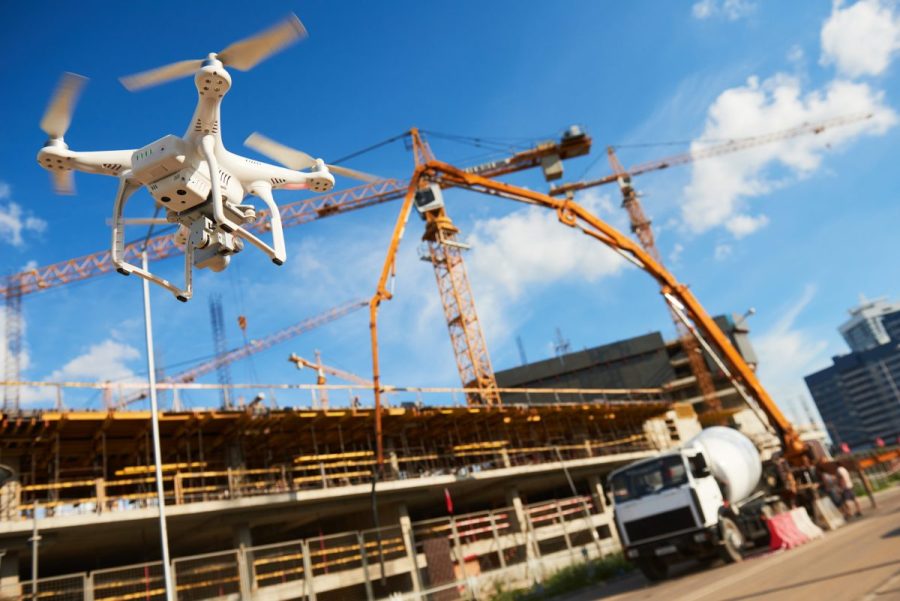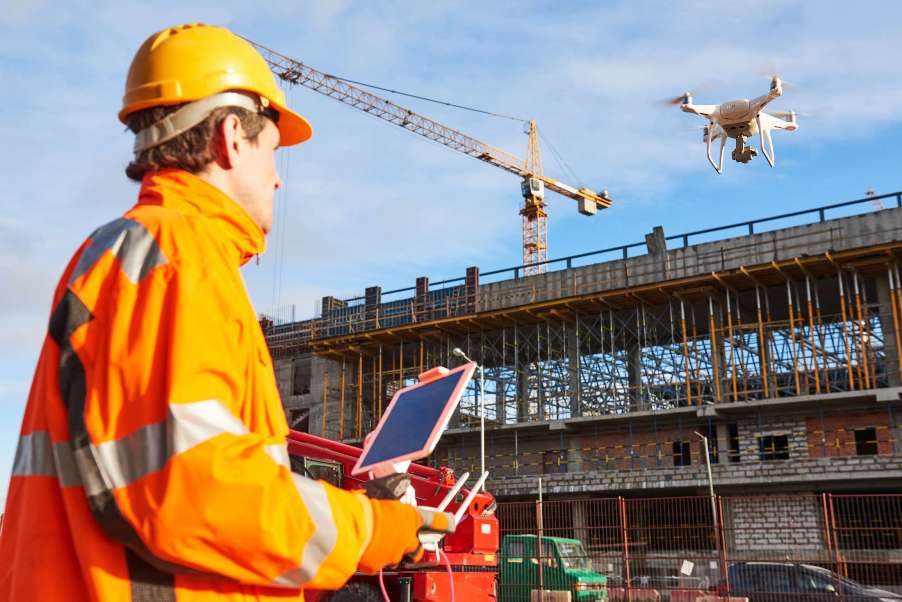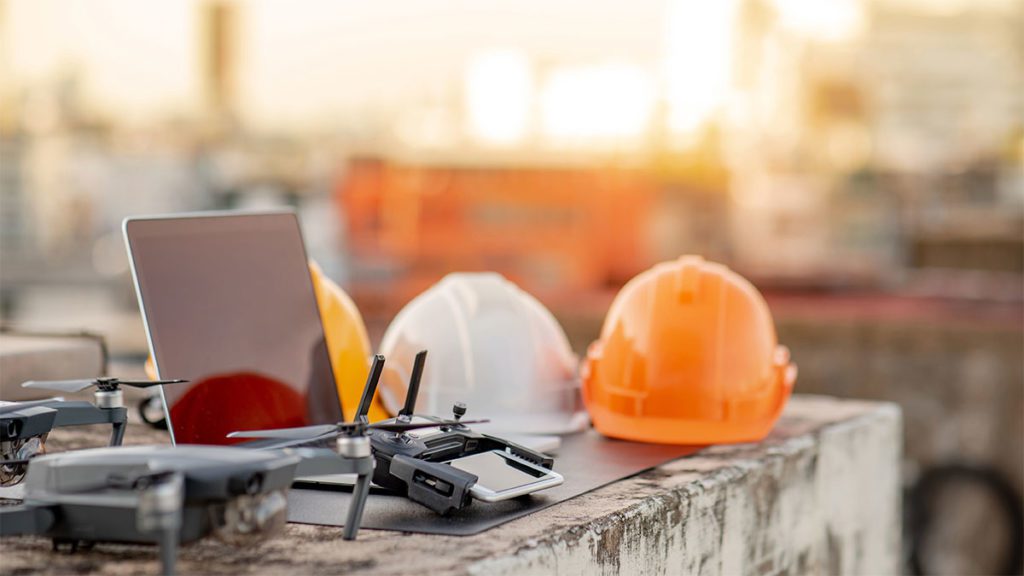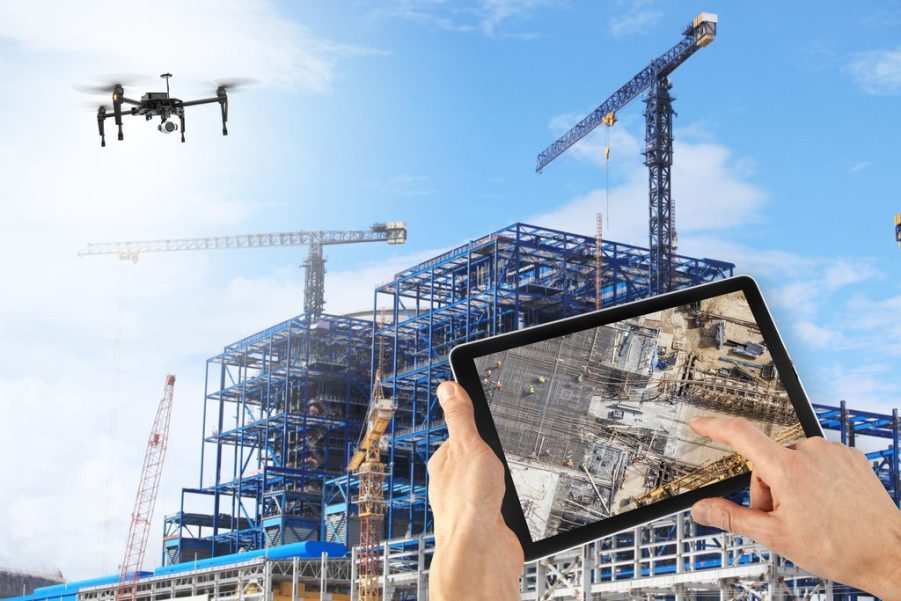While dozens of industries use drones from a commercial drone company, the fastest growing commercial adopter is the construction industry. Drone use on the job site has skyrocketed in the last year - surging 239% - and construction is now the leading sector using Drone.
Builders use drones to collect real-time data about projects and understand what’s happening on site. Aerial insights improve progress tracking and help catch problems early - before they become costly or add weeks to a project’s timeline.
But progress tracking is far from the only way construction companies use drones. By spending less than an hour each week mapping a job site, contractors gain access to an unprecedented amount of knowledge about nearly every aspect of their project. With this data in hand, DroneDeploy’s software makes it easy to plan, communicate, and keep projects on schedule.
Drones do more than improve communication and help keep projects on track. They also increase safety, save time and resources, fast-track surveying, and deliver accurate measurements. We surveyed our construction customers to see exactly how use drones on the job site. Here are the top results.
Potential of drones
Before the use of drone technology in construction, there was a disconnect between viewing a rendering of a job site versus seeing it in reality. Drone technology has revolutionized the way stakeholders view a site and visualize a completed project and allows for much more careful analysis of progress during construction.
According to a 2016 McKinsey report, unmanned aerial vehicles (UAVs), commonly referred to as drones, will dramatically improve the accuracy and speed at which construction projects are completed in the near future. Like flat screen TV’s, a dramatic decrease in the manufacturing cost of technology has dropped the prices of professional grade drones for construction, complete with mountable, lightweight HD cameras and other survey equipment to as little as $700. This technology investment alone can dramatically improve surveys, site visibility, progress reporting, and inspection processes.
A drone program is a terrific investment for construction companies right now. They can be used through the entire construction lifecycle, from feasibility and bidding to handover and maintenance. Here’s how.

Feasibility and Bidding
Drones can be equipped with cameras, geo-location sensors, infrared sensors, and more. The data can then be imported into survey software to create 3D models of existing conditions. This helps with determining feasibility, understanding constructability, and helping owners visualize what the project will look like in the end. It can also be used to identify areas of risk.
Design and Pre-Construction
Drone surveys help inject real-world conditions into design and constructability conversations. The ability to easily capture site information also improves the rate at which the design can be iterated on.
Construction
During the construction phase, drones have many current and potential uses. They help to track and communicate progress, track and manage materials and assets, reduce theft, improve owner visibility, increase safety, and provide valuable information for improving design changes. They also create a valuable documentation trail in case of problems.
Handover and Maintenance
Drone imagery and video of the final product can create customer delight during handover. This data also has a practical value in property management and maintenance, providing owners and managers with visual data regarding the as-built condition of the building. Additionally, drones equipped with thermal imaging capability can detect heat leaks in a building envelope or along a long run of underground utility piping.
Choosing a Drone for Construction
If you’ve decided to proceed with purchasing your drone and run the program in-house, the first thing you’ll want to think about is the type of drone and features that make sense for your application. Here are some of the options that will impact the drone’s usefulness:
- Fixed wing versus vertical-take-off-and-landing (VTOL) verse tethered VTOL
- Size and payload
- Battery life and flight time
- Range and maneuverability
Types of Drone Equipment (Sensors)
While the drones get all the glory, it’s the equipment that makes them more than just a hobbyist’s entertainment. And there are so many choices!
- Photos and video sensors (cameras)
- Geo-location sensors (GPS, for example)
- Thermal sensors for detecting heat

Impact of drone in construction
The presence of drones in construction means significant changes within the industry. Drones have already begun changing the way the construction industry operates, and those changes will have continued and lasting effects. Here’s a look at some of the ways drones have already changed the industry and how these trends will impact construction operations in the future.
Unmanned Aerial Vehicles (UAVs) are rapidly replacing traditional land-surveillance methods. They are growing in popularity so rapidly that some have even abandoned the classic “bird’s-eye view” expression with “drones eye view.” Drones greatly reduce the labor and time involved in producing accurate surveys. Drones eliminate much of the human error involved in the process and have the ability to capture necessary data in much less time than traditional methods would take.
Drones provide superior endurance and intelligence on job sites. Their ability to collect and report data allows them to complete work faster. The need for manual labor is all but removed from the equation. In the future, drones will take on even more integral tasks involved in large projects. They are poised to cut the time it takes to build a skyscraper by a broad margin, thereby cutting costs. Contractors who rely on drones will be able to make much more ambitious bids and complete work on time.
Drone technology has evolved to the point where instant connectivity and communication on the job site are at a surplus. Drones are being used more and more as a means of maintaining constant contact at worksites. Drones that feature mounted cameras can provide video footage to facilitate communication and surveillance. They allow companies to keep tabs on employees and workers and are considered an increasingly invaluable tool for superintendents and investors.
Already, communication and management are seeing a sharp increase in efficiency due to the ability to collect real-time data from drones. The decrease in delays in gathering data is having more of an impact each day. The ability to manage workflow 24/7 is unprecedented and is certain to have a significant impact on all manner of construction processes.

The advent of drones is causing a sharp increase in security efficiency. Whether the drones are used to maintain the safety of employees or to protect the job site from theft or vandalism, they are steadily seeing greater implementation in the construction industry.
Drones can be practically everywhere at the same time. They don’t just reduce theft and keep workers safer; they create an around-the-clock, real-time monitoring system that has already been adopted by several construction companies. They elevate onsite security and safety by a tremendous margin.
Even though the FAA exacts strict standards on the use of drones, most models used by construction companies come in under the 4.4-pound weight threshold and 400-foot travel radius required to be considered hobby class, as reported by The Washington Post.
Drones that meet those criteria are not subject to stringent regulations. As of right now, they can be flown practically anywhere for any reason. Drones can also safely survey dangerous locations, reducing workplace accidents and increasing job site safety.
The use of drones in job site inspection also means a drastic increase in worksite safety by eliminating numerous dangers and safety hazards. Using drones to transport goods aerially allows companies to execute difficult inspections and keep track of everything that enters and leaves the job site. It saves money and time and keeps the site secure.

How are drones used on a construction site?
In the construction industry, drones provide easy access to large or difficult sites as well as complex or tall structures. They can gather aerial data, mapping information and images used for:

Environmental and economic advantage of drones in construction
There are significant environmental and economic benefits to keeping buildings and other types of facilities operational and construction sites safe. But doing so requires slow, dirty, and dangerous work of monitoring and inspection.
One thing that has changed over time is how people construct – the procedures, methods, and effectiveness. While some buildings might follow similar design principles to ones that were built a thousand years ago, they normally won’t have undergone the same construction process.
They are poised to perform many of these types of functions, because they can capture video, take high-resolution images and do laser scanning remotely by an operator on the ground.
Drones have been a major innovation in the last few years, and they’ve increased the number of activities that can be performed for a number of industries.

Their uses are almost unlimited, and the construction industry has certainly seen a huge impact from them as well. Construction companies believe that drones are here to stay because they create a better working environment for employees.
While the uses of drones do not include the actual labour phase of construction (yet), they play a huge role in the planning and analysis process.
Drones are hugely popular in the building industry due to the fact that they provide an aerial view of a site at a comparatively smaller amount of the cost of the construction.
This means they can be used to develop plans, track progress and monitor any issues throughout the construction process. It is a simplified, budget-friendly and faster way to provide an up-to-date aerial view of a site. This has made drones quite popular in the construction industry. This sort of area coverage, in particular, could only previously be made possible with a manned aircraft.
The process involved in mapping a construction site used to be long and difficult, but with the help of the right drone, all that has changed. Not only was it a lengthy process but it was also expensive. Construction companies undertaking large projects had to hire a plane to fly over their large sites to take the needed pictures.
Nowadays, a drone can be programmed to carry out the process in a few short minutes at a fraction of the cost. This lets you get the images much more easily and in less time. It also means that builders on smaller projects can get the right data where they were previously priced out of hiring a plane while eliminating the chances of getting wrong data.

Not only that, but you can also get current images every day to monitor the construction progress if you need to. These drones can also send the appropriate data straight to the right software on a computer so that it can be analysed and compiled in real time. From there, it can be stored and used to create a number of different solutions.
Inspections on a busy construction site can be dangerous – but they’ve become a lot safer with drones. The health and safety risks to employees can be reduced drastically by allowing drones to carry out most of the work, while managers view the footage from the safety of their office, whether real-time or recorded.
Bridge inspection companies have discovered that the use of drones is the best way to complete inspections of structures that are close to the water. Drones have the ability to fly to remote locations, a task that would have taken a group of builders a few days to get to. Drones are also useful during insurance claims, as they are used to provide evidence of construction progress.
In the process of carrying out a building survey, accessing the roof can often be dangerous and difficult. Building surveillance using drones can identify potentially unsafe situations, so they are addressed faster.
Drones can help make the process safer, easier and quicker and allows a surveyor to assess the roof for faults without actually getting on the roof. This means surveyors won’t need scaffolding or ladders and will, therefore, be much safer, and the cost, cheaper.

Conclusion
Today, the impact of drone technology on the digital transformation of the construction industry is undeniable. What started as a recreational toy or novelty camera has quickly become a competitive advantage for those willing to deploy it to their benefit.
Drones can do much more than produce high definition images. Scanning with drones can yield many kinds of useful data. These tools can use add-on equipment such as infrared, geo-locating and thermal sensors to assist in mapping construction sites and modeling construction projects. The footage captured can be converted into 3D models with real-world conditions incorporated, allowing for better iteration, higher feasibility and more accurate bids during the pre-construction phase.
Drones are taking an essential place in the construction process and are only increasing in popularity and functionality. Creative site managers are continually finding new applications for drone technology on construction sites.
Info and image:
mConnect.bim360.autodesk.com, Dronedeploy.com, Thebalancesmb.com, Dronenodes.com



